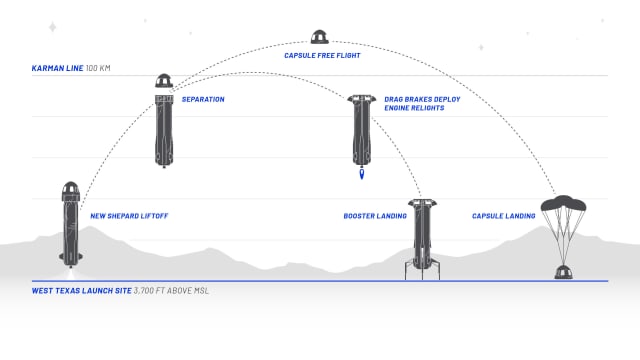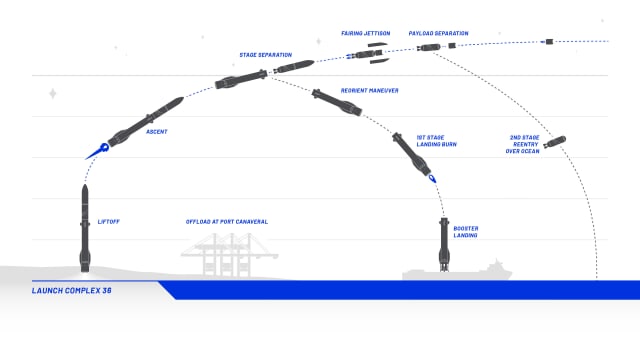Blue Origin Has Been Trying to Get the Hell Off This Planet for 20 Years Now The company hopes to put the next few generations of Earthlings into orbit.
This story originally appeared on Engadget

As a teenager, young Jeff Bezos was fascinated with space exploration. Speaking as the 18-year-old valedictorian of his high school, Bezos told the Miami Herald in 1982 that he planned "to build space hotels, amusement parks and colonies for 2 million or 3 million people who would be in orbit. The goal was to be able to evacuate humans. The planet would become a park."
In the year 2000 — having grown up, founded Amazon, and gained a measly $6 billion net worth — Bezos founded Blue Operations, LLC. Tasked with the mission of sending millions of people to live and work in space, the company has spent the past two decades quietly designing and building rockets to do just that. So, on the twentieth anniversary of its founding, let's take a look at Blue's origins and where the private aerospace company might be headed in the future.
Bezos officially founded Blue Origin on September 8th, 2000 in Kent, Washington (which now houses the company HQ and R&D center) and set about developing both space-worthy vehicles as well as the rocket motors to push them. From the outset, secrecy has been a core tenet of the Blue Origin ethos. The company's existence wasn't even discovered by the public until 2003 when Bezos began buying land in Texas for the company's private suborbital launch and engine test site.
That secrecy continues to this day. In fact, the company repeatedly declined requests for comment regarding this story. Of course there's little reason for the company to chase public input given that, as of 2016 at least, its entire billion-dollar annual operating budget is provided by Bezos himself.
That financial backing has resulted in the development of several spacecraft and engine prototypes. In 2005, the 9,500-pound Charon jet-powered VTOL test platform made its first and only test flight above Moses Lake, Washington. Designed to validate the company's autonomous guidance and control systems, it climbed to a height of 316 feet using its quartet of Rolls-Royce Viper Mk. 301 jet engines. It now lives in the Museum of Flight.
The company built on that effort the following year with a test flight of the Goddard suborbital test vehicle. It was driven by nine pressure-fed peroxide-powered BE-1 rocket engines, Blue Origin's first successful rocket design. The test craft managed to reach a height of nearly 300 feet in the approximately 10 seconds that it was airborne. It made two more flights in 2007 before being retired.
Those early endeavors have paid off in the form of the New Shepard spacecraft, a suborbital vehicle capable of toting crews and cargo out to the Karman line — the internationally defined boundary of Earth and space. In 2006 work began on the New Shepard, named after famed Mercury-era astronaut Alan Shepard. However, it wasn't until the start of last decade and the completion of the BE-3 110,000 lbf liquid hydrox engine, that the vehicles entered the current state of worthiness.
Blue Origin
The New Shepard utilizes a two-part design consisting of a six-person Crew Capsule which sits atop a 60-foot tall reusable VTOL rocket. It's built to launch vertically at speeds reaching Mach 3, then separate at a height of approximately 100 kilometers at which point the rocket stage will guide itself back to Earth while the capsule makes a more leisurely return route under the gentle drag of three parachutes.
Blue Origin has built three New Shepards to date. The first was partially destroyed during a test flight in 2015. (The crew capsule was unharmed; the rocket stage, not so much.) However, the second iteration made five successful flights between 2015 and 2016 while the third has made six successful flights since 2017, ferrying multiple scientific experimental payloads into low orbit. What's more, the New Shepard 3 has reused the same rocket engine on all six trips.
Crewed flights aboard the New Shepard 4 were originally scheduled to take place in 2018, but those flights have been repeatedly delayed for the past two years. The company is reportedly still eyeing a potential crewed flight at some point in 2020, though given that we're already into September, that's not looking particularly likely at this point.
Looking ahead, Blue Origin has even greater goals in sight. The company is currently preparing its latest spacecraft, the 45-metric-ton New Glenn for a test flight in 2021. It comes in two variants: a 270-foot-tall two-stage rocket and a 313-foot-tall three-stage rocket. The larger variant will be able to exceed low Earth orbit. The New Glenn is just a touch shorter than the venerated Saturn V that first brought people to the moon. Like its predecessor, the New Glenn will leverage a reusable rocket to get into space, though it will not be the BE-3 engines seen in the Shepard — at least in the first stage.
Blue Origin
Instead, the Glenn will fly with the new 550,000 lbf BE-4, which relies on a mixture of liquid oxygen and methane to provide thrust. It will be powerful enough to haul as much as 13 tons of cargo into orbit on each trip. BE-3s will still be onboard, but they'll be located in the second stage which is tasked with delivering the payload into its correct orbit once it passes the Karman line. And like SpaceX's Falcon 9, New Glenn's first stage will autonomously guide itself back to Earth following separation and land unassisted on an oceanic landing pad.
Even more impressive are Blue Origin's plans to go to the moon and potentially even farther than that. This past April NASA began doling out contracts as part of its Back to the Moon program (aka Artemis), which aims to deposit human astronauts at the moon's South Pole by 2024. Blue Origin, SpaceX and Dynetics all received funding to help the firms develop their lunar lander platforms. Blue Origin received a lion's share of the money — $579 million, all told — to build the Blue Moon. The three firms have until February 2021 to build the landers and complete a mockup mission before NASA starts thinning the competitors.
"We are going to build a road to space," Bezos said during a press event unveiling the Blue Moon in May. "And then amazing things will happen."
Like the Glenn, the Blue Moon lander will come in a pair of variants: one for cargo and another for people. The cargo version will be spacious enough to fit multiple tons of rovers and preconstructed habitats while the people mover was developed in conjunction with Lockheed Martin, Northrop Grumman, and Draper. Blue Origin delivered its Blue Moon mockup to NASA at Johnson Space Center just last month. The 40-foot prototype is based off the original Apollo era lander and was built to help NASA validate its design and function compared to its competitors. Specifically, Blue Origin constructed the lander itself (i.e., the descent element) while Lockheed took care of the ascent element which will shuttle astronauts from the lunar surface back into orbit, Northrop handled the transfer element which connects Blue Moon to the Orion vehicle which will fly them out from the Earth and Draper developed the system avionics.
"Testing this engineering mockup for crew interaction is a step toward making this historic mission real," said Brent Sherwood, Blue Origin's vice president of Advanced Development Programs, in a statement. "The learning we get from full-scale mockups can't be done any other way. Benefitting from NASA's expertise and feedback at this early stage allows us to develop a safe commercial system that meets the agency's needs."
Bezos cites the increased energy demands of better living standards for people as a contributor to his off-world goals. "We will run out of energy," Bezos said during the presentation. "This is just arithmetic. It's going to happen. Do we want stasis and rationing or do we want dynamism and growth? This is an easy choice. We know what we want. We just have to get busy."











